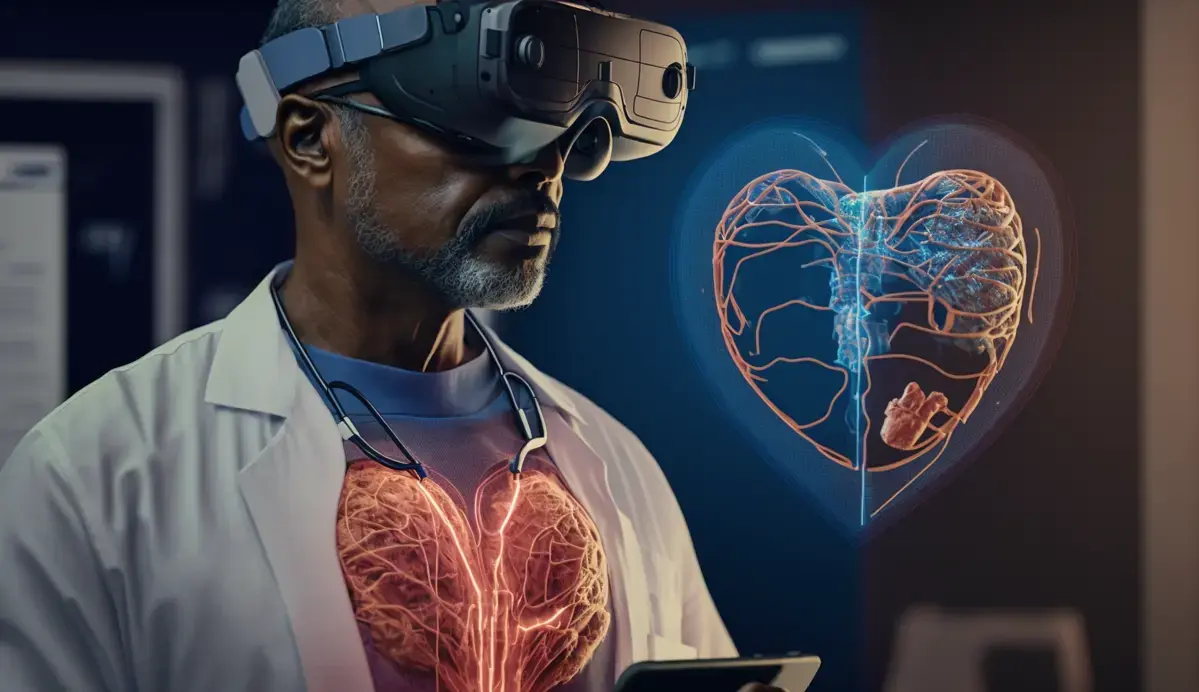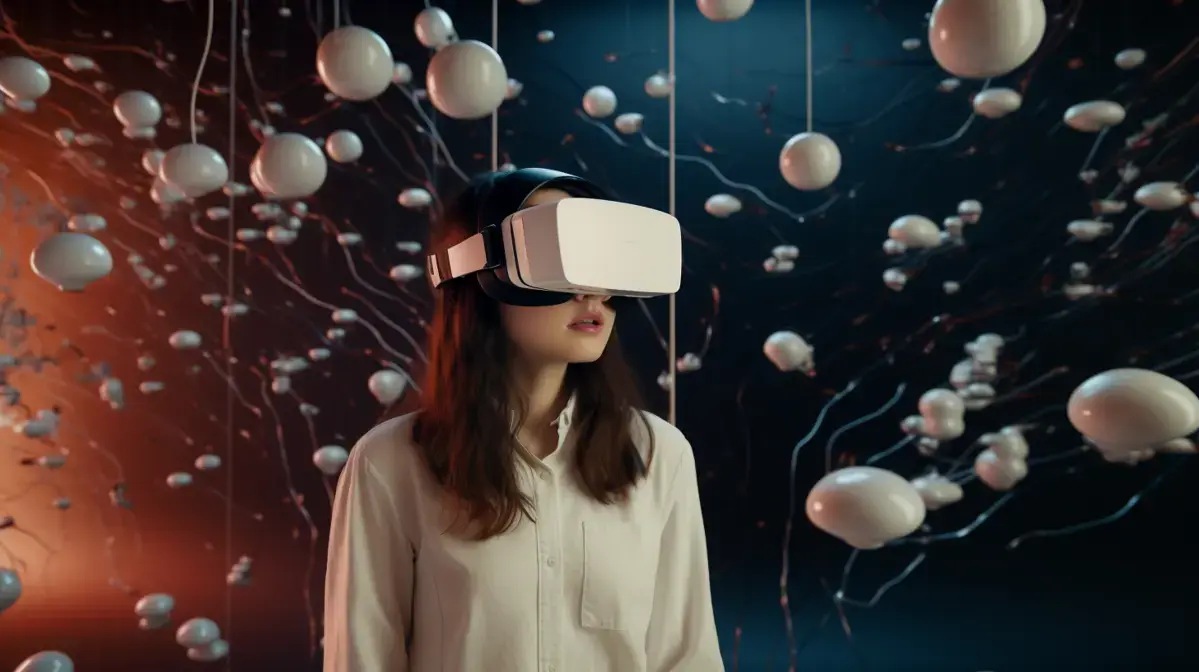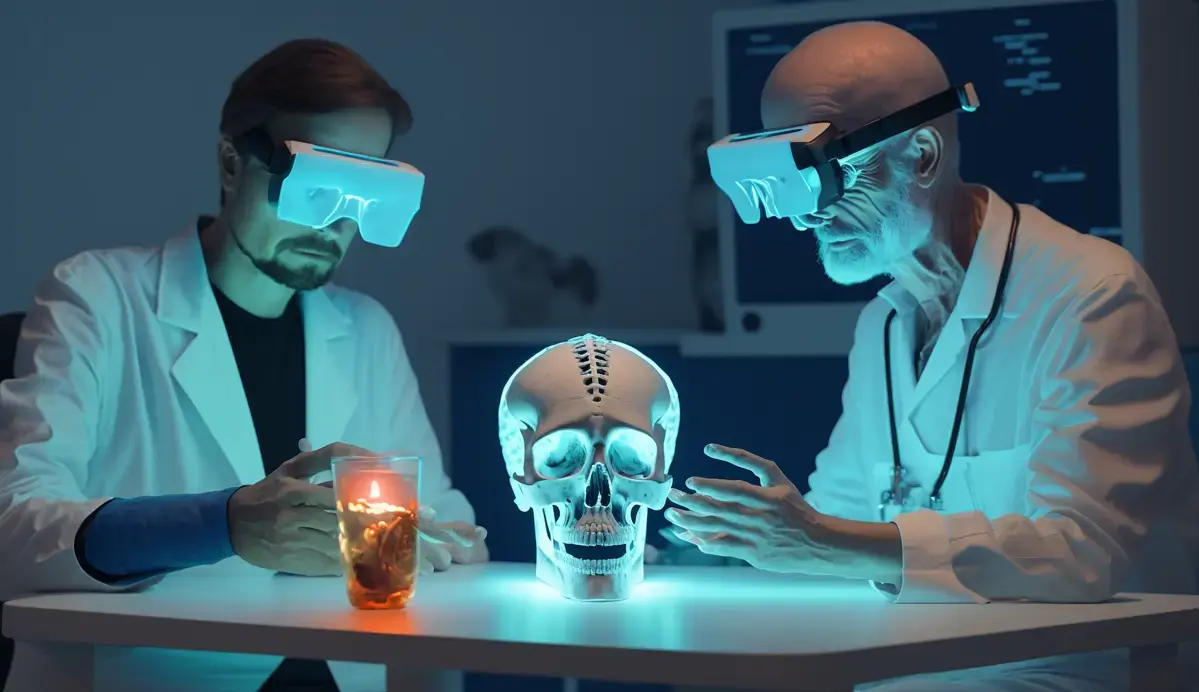Augmented Reality (AR) is a promising technology with numerous healthcare applications. For instance, it can be used for training purposes, enabling medical students to practice procedures in a safe environment. Additionally, AR devices can provide real-time guidance during surgeries and assist doctors in the accurate placement of implants or catheters.
The use of AR in physical therapy has also shown great promise. Patients recovering from injuries or surgeries can benefit from augmented reality-based exercise programs that monitor their movements and adjust routines accordingly.
However, implementing AR solutions in healthcare comes with its own set of challenges such as patient privacy concerns and high costs associated with the adoption of new technologies.
Despite these challenges though, there are many reasons why both patients and physicians are excited about the potential benefits that augmented reality holds for healthcare. Not only does it help improve diagnostic accuracy but also provides an immersive experience that enhances patient engagement during treatments.
In conclusion, if you’re interested to learn more about Augmented Reality’s applications across different industries including Healthcare visit argeopin website today.
Table Of Contents
- Key Points
- Introduction to Augmented Reality and Virtual Reality in Healthcare
- Interesting Facts
- Applications of Augmented Reality in Healthcare: Improving Diagnosis and Treatment
- Benefits of Using Augmented Reality for Medical Training and Education
- The Role of Augmented Reality in Telemedicine: Enhancing Remote Patient Care
- FAQs
- Challenges Faced by Healthcare Industry While Implementing Augmented Reality Technology
- Future Prospects of the Use of Augmented Reality in Medical Field
- Ethical Considerations Surrounding the Use of Augmented Reality in Healthcare
- Key Takeaways

Key Points
- Augmented Reality and Virtual Reality have immense potential in the healthcare industry.
- Augmented Reality can aid medical professionals during surgeries, training and diagnosis, while Virtual Reality can be utilized for pain management and therapy.
- The challenges in implementing AR/VR technology in healthcare include high cost of implementation, lack of trained personnel to operate the technology effectively and concerns over patient privacy.
- The use of AR/VR technology has shown promising results with improved outcomes for patients including reduced medication usage, decreased recovery times, increased precision during surgeries among others.
Introduction to Augmented Reality and Virtual Reality in Healthcare
Augmented Reality and Virtual Reality (AR/VR) are no longer just buzzwords in the tech industry. They have been making waves in several sectors, including healthcare, where their potential to improve patient outcomes and experiences is becoming increasingly evident.
As an AR expert with years of experience working on projects in the healthcare sector, it’s been fascinating to see how this technology has evolved over time. The ability to superimpose digital information onto real-world environments can revolutionize everything from medical training to surgical procedures.
One example of AR’s impact on healthcare is its use for surgical planning. With AR glasses or headsets, surgeons can view a patient’s anatomy more accurately than ever before by overlaying CT scans onto their body during surgery preparation. This allows them to plan out complex surgeries with greater precision which ultimately leads less invasive surgeries resulting in quicker healing times for patients.
Another exciting application of VR technology lies within therapy treatments as well such as immersive virtual reality exposure therapy that helps individuals struggling with anxiety disorders learn coping mechanisms through simulated scenarios without having an actual panic attack -giving hope that you do not have be anxious anymore.
These applications are just a few examples among many potential uses for these technologies within medicine and beyond. As we continue advancing technologically at an unprecedented speed who knows what other amazing breakthroughs will occur?
Interesting Facts
- The first virtual reality headset was created in 1968 by Ivan Sutherland and was called “The Sword of Damocles”.
- A study conducted by Cedars-Sinai Medical Center found that the use of augmented reality during surgery resulted in a 10% increase in accuracy compared to traditional methods.
- The global market for AR and VR technology is predicted to reach $18.8 billion by 2020.
- In Japan, there are hospitals that use virtual reality technology to help burn victims manage pain during wound care procedures.
- Stanford University uses augmented reality simulations to train medical students before they work with live patients, reducing the risk of error or injury.

Applications of Augmented Reality in Healthcare: Improving Diagnosis and Treatment
If you’re an English-born Augmented Reality expert, then chances are you’ve been in the industry for a while. You may have seen firsthand how AR technology has evolved and improved over time. And if that’s the case, then there’s no doubt that you understand just how impactful this technology can be – especially when it comes to healthcare.
AR and VR technologies offer unparalleled opportunities to transform healthcare as we know it. For example, they can help doctors to view 3D images of their patients’ organs during surgery or enable medical practitioners in rural areas lacking standard facilities access advanced training through virtual simulations.
In addition to supporting advanced diagnosis and high-quality patient care delivery from anywhere around the world, AR also offers new ways of educating people about health issues such as diabetes or mental illness by transforming learning into interactive experiences. This immersive approach helps patients better understood complex topics while creating greater empathy between them and their caregivers
As someone deeply passionate about AR innovation advancements who has experienced working with these technologies through various projects on startups across several industries including farming agriculture applications where farmers use augmented reality visualizations when identifying pests on crops; I firmly believe that Augmented Reality is one of those innovative solutions set transform healthcare forever.
Benefits of Using Augmented Reality for Medical Training and Education
Augmented Reality (AR) and Virtual Reality (VR) have been game-changers in the healthcare industry. From patient care to medical training, these immersive technologies are transforming the way we approach healthcare.
The ability to overlay digital information onto real-world environments has endless applications in healthcare. For example, imagine being able to project a 3D image of a patient’s MRI scan directly onto their body during surgery? This would provide surgeons with greater precision and accuracy when performing complex procedures.
In addition, VR is also making waves in healthcare education and training. Medical students can now simulate surgeries or other procedures using VR technology before ever working on a live patient. This not only improves their technical skills but also helps them develop critical decision-making abilities under pressure.
AR/VR is even helping patients themselves through therapy treatments for conditions such as post-traumatic stress disorder or chronic pain management by providing an immersive environment that promotes healing experiences without triggering unwanted reactions.
The potential for AR/VR use cases within Healthcare is practically limitless. From therapeutic applications aiding mental health treatment through increased access, i.e., virtual reality exposure therapy for PTSD sufferers who may not be able or willing to engage with traditional therapies like talking-based clinical psychology methods, should be more widespread across hospitals worldwide.
These examples are just scratching the surface when it comes down to how augmented reality/virtual reality will transform medicine – from doctors utilizing holographic displays showing organs inside our bodies’ different states right up until gamifying exercises which help improve people’s motor functions recovering after injury/surgery. The possibilities truly feel boundless.
The Role of Augmented Reality in Telemedicine: Enhancing Remote Patient Care
Augmented Reality (AR) and Virtual Reality (VR) are two of the most revolutionary technologies to impact healthcare in recent years. Healthcare professionals now have an array of innovative tools at their disposal that can enhance patient care, increase accuracy and improve outcomes. With AR, doctors can overlay virtual information onto real-world medical images like X-rays or MRIs, giving them unprecedented insight into what’s happening within a patient’s body.
One such example is AccuVein Inc., which has developed handheld scanners that project AR overlays onto a patient’s skin to help clinicians locate veins for blood draws or IV placement quickly. This technology makes it easier for clinicians to access patients with low muscle volume and those whose veins are hard-to-find during conventional techniques easily.
Similarly, VR technology provides immersive experiences which simulate real-life events/training scenarios for clinicians, allowing them to test different solutions before applying them in the clinic safely. This, in turn, reduces on-the-job mistakes while increasing efficiency levels by providing better contexts about how these procedures work practically.
It’s no stretch saying that both these technologies have made massive strides towards solving some very critical challenges faced by healthcare providers worldwide through increased sensory input. This leads to more informed examination processes, ensuring faster treatment times and improving overall general well-being of Patients requiring treatments – all without needing any invasive measures whatsoever.
FAQs
Q: What is augmented reality in healthcare?
A: Augmented reality (AR) is a technology that overlays digital information onto the real-world environment. In healthcare, AR can be used to enhance medical training simulations, patient education and visualization during surgical procedures.
Q: How can virtual reality be applied in the healthcare industry?
A: Virtual Reality (VR) has potential therapeutic benefits for patients including pain management and mental health disorders like anxiety and PTSD. It can also aid doctors with remote consultations by providing them an immersive view of their patient’s condition.
Q: What are some challenges faced while implementing AR/VR in Healthcare?
A: One major challenge is ensuring data privacy when collecting sensitive medical information from patients using VR devices. Another hurdle includes lack of standardization across different hardware platforms making it difficult for developers to create universally compatible applications.
Q :What role do wearables play in AR/VR technology advancements for Healthcare sector?
A : Wearable devices such as smart watches have enabled doctors to monitor vitals remotely from their patients without requiring them physically present at hospital or clinic premises. Incorporating these wearable devices into AR & VR experiences could significantly improve how physicians diagnose and treat illnesses especially chronic conditions .

Challenges Faced by Healthcare Industry While Implementing Augmented Reality Technology
Augmented Reality (AR) and Virtual Reality (VR) are rapidly changing the healthcare industry by creating new and innovative ways to improve patient care. AR allows the user to see real-world objects enhanced with computer-generated information, while VR creates a simulated environment that users can explore. Both technologies offer unique benefits that can enhance medical training, treatment options, surgery planning and more.
It is incredibly exciting for me to be at the forefront of this tech revolution. One example of AR being used in Healthcare is through simulation training for surgeries or procedures which allows doctors-in-training hands-on virtual experience before performing on actual patients.
There are also various examples like how wearable devices equipped with AR allow visually impaired individuals to navigate their surroundings independently- giving them a sense of freedom they would not have otherwise had. Researchers believe these types of tools will become increasingly valuable as our population continues aging and vision problems become more prevalent.
Finally let us not forget about Virtual reality exposure therapy which uses VR technology as part of cognitive-behavioral psychotherapy treatment plans aimed at phobia reduction or other affective disorders such as PTSD. By simulating traumatic experiences within a safe environment therapists hope it will help those affected develop coping mechanisms outside virtual worlds too.
In all these cases , augmented reality technology has proven useful in helping solve complex issues related patient care & well-being . As time goes on we expect even newer possibilities emerge from continued research & development into these revolutionary technologies.
Future Prospects of the Use of Augmented Reality in Medical Field
Augmented Reality (AR) and Virtual Reality (VR) technology has been a game-changer in the healthcare industry. Gone are the days when patients had to rely solely on traditional medicine to receive treatment. AR and VR have revolutionized how medical professionals diagnose, treat, and cure various illnesses.
Imagine putting on a pair of smart glasses that can detect vital signs such as blood pressure, pulse rate, body temperature etc., while simultaneously projecting relevant health information onto your field of vision in real-time? This is just one example of how AR/VR technology has transformed healthcare.
Medical students too can now benefit from this innovative technology by practicing simulated surgeries with 3D models before operating on actual patients. In doing so they will gain confidence as well as reducing errors during surgery ultimately giving better care for their patient’s wellbeing.
Furthermore, mental illness sufferers who struggle with phobias or anxiety disorders can undergo exposure therapy through virtual reality sessions, providing an opportunity for them to overcome their fears in a safe environment without having physical interaction, which causes them more stress than good.
In conclusion, it is evident that augmented reality and virtual reality technologies provide endless opportunities within the medical sector, improving overall accuracy resulting from early diagnoses due to regular monitoring, therefore increasing chances at curing specific illnesses before reaching advanced stages where complications arise, causing further problems. Thus, continuing efforts should be made promoting research into these fields, ensuring progress takes place rapidly.
Ethical Considerations Surrounding the Use of Augmented Reality in Healthcare
Augmented Reality (AR) and Virtual Reality (VR) have long been at the forefront of technology, transforming industries in ways we could never imagine. However, nowhere is this transformation more exciting or critical than within healthcare. AR and VR open up new possibilities for medical professionals in training, diagnostics and treatment.
As an expert with years of experience working with AR applications within the healthcare sector, it’s clear that these technologies can revolutionize how we approach medicine. With Augmented Reality headsets like Microsoft HoloLens or Google Glass Enterprise Edition providing 3D visualizations directly over a patient’s anatomy during surgery or other procedures – surgical teams are able to view vital organs from different angles without traditional invasive techniques. Imagine being able to ‘see’ inside someone as if you were examining them through an X-ray machine.
The benefits don’t stop there either: augmented reality also allows doctors to practice complex surgeries beforehand – reducing risks significantly whilst enhancing precision. The ability for remote consultations is another application proving popular post-COVID19; patients are now enjoying the convenience of virtual checkups which not only saves time but reduces unnecessary physical contact.
Overall, it’s clear that applying augmented reality technologies designed specifically for use in clinical settings can improve both outcomes and quality-of-life across many medical disciplines by improving efficiency while reducing overall risk related factors such as infection rates–which ultimately lead us into a safer future.
Conclusion
Augmented reality (AR) and virtual reality (VR) have immense potential in transforming the healthcare industry. With AR, medical professionals can visualize complex anatomical structures and perform real-time surgeries with precision. VR provides an immersive environment for medical training, patient therapy, and rehabilitation exercises.
However, there are several challenges that need to be addressed before AR/VR becomes mainstream in healthcare. These include regulatory hurdles concerning data privacy and security of patient information, high development costs of the technology as well as accessibility issues among patients who may not have access to advanced technology.
Overall, despite the challenges involved in implementing these technologies into routine clinical practice on a mass scale; when properly utilized they present an innovative opportunity for creating new therapeutic interventions or treatment plans that would otherwise be challenging or impossible without their use — thereby revolutionizing how we approach healthcare delivery today.
Key Takeaways
- Augmented reality and virtual reality have numerous applications in healthcare, including patient education and training for medical professionals.
- The use of these technologies can lead to improved surgical outcomes, reduced errors during surgery, and increased patient safety.
- Challenges include high costs associated with implementing the technology, limited access to the necessary hardware/software infrastructure in certain regions or facilities.
- The need for specialized training among medical staff to operate AR/VR systems effectively is also a challenge that needs attention.

